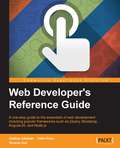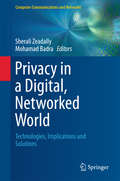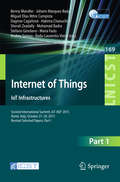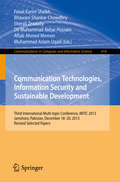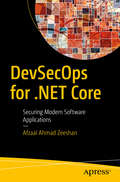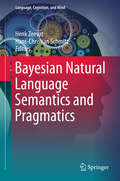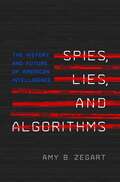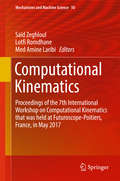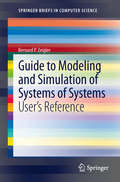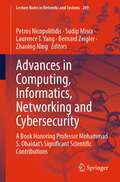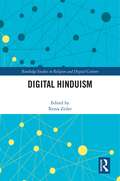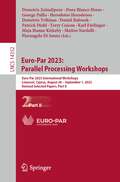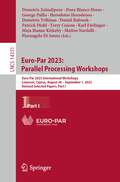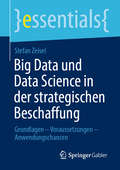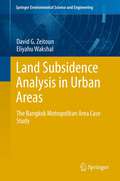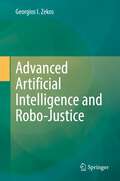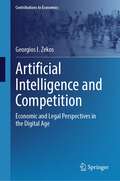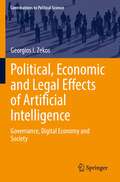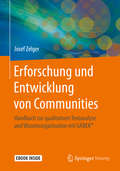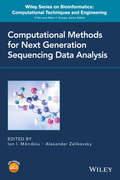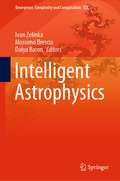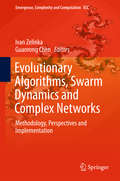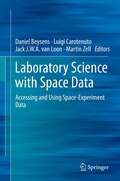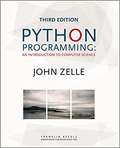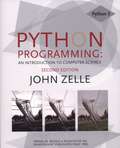- Table View
- List View
Web Developer's Reference Guide
by Ricardo Zea Talha Khan Joshua JohananA one-stop guide to the essentials of web development including popular frameworks such as jQuery, Bootstrap, AngularJS, and Node.js About This Book * Understand the essential elements of HTML, CSS, and JavaScript, including how and when to use them * Walk through three of the best and most popular web development frameworks - jQuery, Bootstrap, and AngularJS * References for any function you will need in your day-to-day web development Who This Book Is For This book is perfect for beginners but more advanced web developers will also benefit. Laid out so you can refer to as much or as little as you need to, with this book you can exhaustively explore essential concepts for modern web developers. What You Will Learn * Explore detailed explanations of all the major HTML elements and attributes, illustrated with examples * Take a deep dive into CSS properties and functions and master their usage * Find clear, concise descriptions of JavaScript syntax and expressions * Recognize various JavaScript design patterns and learn the basics of JavaScript object-orientated programming * Implement the latest ECMAScript 6 for client-side scripting in your web applications * Discover new ways to develop your website's front end quickly and easily using Bootstrap * Write JavaScript extensibly using jQuery-JavaScript's feature-rich library * Delve into the key Node.js modules used in JavaScript server-side programming * Access AngularJS 's important modules, controllers, directives, and services quickly In Detail This comprehensive reference guide takes you through each topic in web development and highlights the most popular and important elements of each area. Starting with HTML, you will learn key elements and attributes and how they relate to each other. Next, you will explore CSS pseudo-classes and pseudo-elements, followed by CSS properties and functions. This will introduce you to many powerful and new selectors. You will then move on to JavaScript. This section will not just introduce functions, but will provide you with an entire reference for the language and paradigms. You will discover more about three of the most popular frameworks today--Bootstrap, which builds on CSS, jQuery which builds on JavaScript, and AngularJS, which also builds on JavaScript. Finally, you will take a walk-through Node.js, which is a server-side framework that allows you to write programs in JavaScript. Style and approach This book is an easy-to-follow, comprehensive reference guide. Each topic, function, or element is listed methodically along with parameters, return values, and descriptions. Examples are also included to help you put the concepts to use quickly in the real world.
Privacy in a Digital, Networked World
by Sherali Zeadally Mohamad BadraThis comprehensive textbook/reference presents a focused review of the state of the art in privacy research, encompassing a range of diverse topics. The first book of its kind designed specifically to cater to courses on privacy, this authoritative volume provides technical, legal, and ethical perspectives on privacy issues from a global selection of renowned experts. Features: examines privacy issues relating to databases, P2P networks, big data technologies, social networks, and digital information networks; describes the challenges of addressing privacy concerns in various areas; reviews topics of privacy in electronic health systems, smart grid technology, vehicular ad-hoc networks, mobile devices, location-based systems, and crowdsourcing platforms; investigates approaches for protecting privacy in cloud applications; discusses the regulation of personal information disclosure and the privacy of individuals; presents the tools and the evidence to better understand consumers' privacy behaviors.
Internet of Things. IoT Infrastructures: Second International Summit, IoT 360° 2015, Rome, Italy, October 27-29, 2015. Revised Selected Papers, Part I (Lecture Notes of the Institute for Computer Sciences, Social Informatics and Telecommunications Engineering #169)
by Sherali Zeadally Hakima Chaouchi Mohamad Badra Radu-Laurentiu Vieriu Benny Mandler Dagmar Cagáňová Johann Marquez-Barja Miguel Elias Mitre Campista Stefano Giordano Maria Fazio Andrey SomovThe two-volume set LNICST 169 and 170 constitutes the thoroughly refereed post-conference proceedings of the Second International Internet of Things Summit, IoT 360° 2015, held in Rome, Italy, in October 2015. The IoT 360° is an event bringing a 360 degree perspective on IoT-related projects in important sectors such as mobility, security, healthcare and urban spaces. The conference also aims to coach involved people on the whole path between research to innovation and the way through to commercialization in the IoT domain. This volume contains 62 revised full papers at the following four conferences: The International Conference on Safety and Security in Internet of Things, SaSeIoT, the International Conference on Smart Objects and Technologies for Social Good, GOODTECHS, the International Conference on Cloud, Networking for IoT systems, CN4IoT, and the International Conference on IoT Technologies for HealthCare, HealthyIoT.
Communication Technologies, Information Security and Sustainable Development: Third International Multi-topic Conference, IMTIC 2013, Jamshoro, Pakistan, December 18--20, 2013, Revised Selected Papers (Communications in Computer and Information Science #414)
by Sherali Zeadally Faisal Karim Shaikh Bhawani Shankar Chowdhry Dil Muhammad Akbar Hussain Aftab Ahmed Memon Muhammad Aslam UqailiThis book constitutes the thoroughly refereed proceedings of the Third International Multi-topic Conference on Communications, Technologies, Information Security and Sustainable Development, IMTIC 2013, held in Jamshoro, Pakistan, in December 2013. The 27 revised papers presented in this volume were carefully reviewed and selected from 140 submissions. The topics presented had a reasonable balance between theory and practice in multi-disciplined topics including wireless sensor networks, cloud computing, wireless communication, antenna design, signal processing, software engineering, image processing, bioinformatics and telemedicine, neural networks, automation and control, and green renewable energy.
DevSecOps for .NET Core: Securing Modern Software Applications
by Afzaal Ahmad ZeeshanAutomate core security tasks by embedding security controls and processes early in the DevOps workflow through DevSecOps. You will not only learn the various stages in the DevOps pipeline through examples of solutions developed and deployed using .NET Core, but also go through open source SDKs and toolkits that will help you to incorporate automation, security, and compliance. The book starts with an outline of modern software engineering principles and gives you an overview of DevOps in .NET Core. It further explains automation in DevOps for product development along with security principles to improve product quality. Next, you will learn how to improve your product quality and avoid code issues such as SQL injection prevention, cross-site scripting, and many more. Moving forward, you will go through the steps necessary to make security, compliance, audit, and UX automated to increase the efficiency of your organization. You’ll see demonstrations of the CI phase of DevOps, on-premise and hosted, along with code analysis methods to verify product quality. Finally, you will learn network security in Docker and containers followed by compliance and security standards. After reading DevSecOps for .NET Core, you will be able to understand how automation, security, and compliance works in all the stages of the DevOps pipeline while showcasing real-world examples of solutions developed and deployed using .NET Core 3. What You Will Learn Implement security for the .NET Core runtime for cross-functional workloads Work with code style and review guidelines to improve the security, performance, and maintenance of components Add to DevOps pipelines to scan code for security vulnerabilities Deploy software on a secure infrastructure, on Docker, Kubernetes, and cloud environments Who This Book Is ForSoftware engineers and developers who develop and maintain a secure code repository.
Bayesian Natural Language Semantics and Pragmatics (Language, Cognition, and Mind #2)
by Henk Zeevat Hans-Christian SchmitzThe contributions in this volume focus on the Bayesian interpretation of natural languages, which is widely used in areas of artificial intelligence, cognitive science, and computational linguistics. This is the first volume to take up topics in Bayesian Natural Language Interpretation and make proposals based on information theory, probability theory, and related fields. The methodologies offered here extend to the target semantic and pragmatic analyses of computational natural language interpretation. Bayesian approaches to natural language semantics and pragmatics are based on methods from signal processing and the causal Bayesian models pioneered by especially Pearl. In signal processing, the Bayesian method finds the most probable interpretation by finding the one that maximizes the product of the prior probability and the likelihood of the interpretation. It thus stresses the importance of a production model for interpretation as in Grice's contributions to pragmatics or in interpretation by abduction.
Spies, Lies, and Algorithms: The History and Future of American Intelligence
by Amy B. ZegartA riveting account of espionage for the digital age, from one of America’s leading intelligence expertsSpying has never been more ubiquitous—or less understood. The world is drowning in spy movies, TV shows, and novels, but universities offer more courses on rock and roll than on the CIA and there are more congressional experts on powdered milk than espionage. This crisis in intelligence education is distorting public opinion, fueling conspiracy theories, and hurting intelligence policy. In Spies, Lies, and Algorithms, Amy Zegart separates fact from fiction as she offers an engaging and enlightening account of the past, present, and future of American espionage as it faces a revolution driven by digital technology.Drawing on decades of research and hundreds of interviews with intelligence officials, Zegart provides a history of U.S. espionage, from George Washington’s Revolutionary War spies to today’s spy satellites; examines how fictional spies are influencing real officials; gives an overview of intelligence basics and life inside America’s intelligence agencies; explains the deadly cognitive biases that can mislead analysts; and explores the vexed issues of traitors, covert action, and congressional oversight. Most of all, Zegart describes how technology is empowering new enemies and opportunities, and creating powerful new players, such as private citizens who are successfully tracking nuclear threats using little more than Google Earth. And she shows why cyberspace is, in many ways, the ultimate cloak-and-dagger battleground, where nefarious actors employ deception, subterfuge, and advanced technology for theft, espionage, and information warfare.A fascinating and revealing account of espionage for the digital age, Spies, Lies, and Algorithms is essential reading for anyone who wants to understand the reality of spying today.
Computational Kinematics: Proceedings of the 7th International Workshop on Computational Kinematics that was held at Futuroscope-Poitiers, France, in May 2017 (Mechanisms and Machine Science #50)
by Saïd Zeghloul Med Amine Laribi Lotfi RomdhaneThis is the proceedings of IFToMM CK 2017, the 7th International Workshop on Computational Kinematics that was held in Futuroscope-Poitiers, France in May 2017. Topics treated include: kinematic design and synthesis, computational geometry in kinematics, motion analysis and synthesis, theory of mechanisms, mechanism design, kinematical analysis of serial and parallel robots, kinematical issues in biomechanics, molecular kinematics, kinematical motion analysis and simulation, geometric constraint solvers, deployable and tensegrity structures, robot motion planning, applications of computational kinematics, education in computational kinematics, and theoretical foundations of kinematics. Kinematics is an exciting area of computational mechanics and plays a central role in a great variety of fields and industrial applications nowadays. Apart from research in pure kinematics, the field deals with problems of practical relevance that need to be solved in an interdisciplinary manner in order for new technologies to develop. The results presented in this book should be of interest for practicing and research engineers as well as Ph. D. students from the fields of mechanical and electrical engineering, computer science, and computer graphics.
Guide to Modeling and Simulation of Systems of Systems: User's Reference
by Bernard ZeiglerThis user's reference is a companion to the separate book also titled "Guide to Modelling and Simulation of Systems of Systems." The principal book explicates integrated development environments to support virtual building and testing of systems of systems, covering in some depth the MS4 Modelling EnvironmentTM. This user's reference provides a quick reference and exposition of the various concepts and functional features covered in that book. The topics in the user's reference are grouped in alignment with the workflow displayed on the MS4 Modeling EnvironmentTM launch page, under the headings Atomic Models, System Entity Structure, Pruning SES, and Miscellaneous. For each feature, the reference discusses why we use it, when we should use it, and how to use it. Further comments and links to related features are also included.
Advances in Computing, Informatics, Networking and Cybersecurity: A Book Honoring Professor Mohammad S. Obaidat’s Significant Scientific Contributions (Lecture Notes in Networks and Systems #289)
by Bernard Zeigler Sudip Misra Laurence T. Yang Petros Nicopolitidis Zhaolng NingThis book presents new research contributions in the above-mentioned fields. Information and communication technologies (ICT) have an integral role in today’s society. Four major driving pillars in the field are computing, which nowadays enables data processing in unprecedented speeds, informatics, which derives information stemming for processed data to feed relevant applications, networking, which interconnects the various computing infrastructures and cybersecurity for addressing the growing concern for secure and lawful use of the ICT infrastructure and services.Its intended readership covers senior undergraduate and graduate students in Computer Science and Engineering and Electrical Engineering, as well as researchers, scientists, engineers, ICT managers, working in the relevant fields and industries.
Digital Hinduism (Routledge Studies in Religion and Digital Culture)
by Xenia ZeilerDigital Religion does not simply refer to religion as it is carried out online, but more broadly studies how digital media interrelate with religious practice and belief. This collection explores Digital Hinduism and consequentially studies how Hinduism is expressed in the digital sphere and how Hindus utilise digital media. Highlighting digital Hinduism and including case studies with foci on India, Asia and the global Hindu diaspora, this book features contributions from an interdisciplinary and international panel of academics. The chapters focus on specific case studies, which in summary exemplify the wide variety and diversity of what constitutes Digital Hinduism today. Applying methods and research questions from various disciplinary backgrounds appropriate to the study of religion and digital culture, such as Religious Studies, South Asian Studies, Anthropology and Media and Communication Studies, this book is vital reading for any scholar interested in the relationship between religion and the digital world.
Euro-Par 2023: Euro-Par 2023 International Workshops, Limassol, Cyprus, August 28 – September 1, 2023, Revised Selected Papers, Part II (Lecture Notes in Computer Science #14352)
by Demetris Zeinalipour Dora Blanco Heras George Pallis Herodotos Herodotou Demetris Trihinas Daniel Balouek Patrick Diehl Terry Cojean Karl Fürlinger Maja Hanne Kirkeby Matteo Nardelli Pierangelo Di SanzoThis book constitutes revised selected papers from the workshops held at the 29th International Conference on Parallel and Distributed Computing, Euro-Par 2023, which took place in Limassol, Cyprus, during August 28–September 1, 2023. The 42 full papers presented in this book together with 11 symposium papers and 14 demo/poster papers were carefully reviewed and selected from 55 submissions. The papers cover covering all aspects of parallel and distributed processing, ranging from theory to practice, from small to the largest parallel and distributed systems and infrastructures, from fundamental computational problems to applications, from architecture, compiler, language and interface design and implementation, to tools, support infrastructures, and application performance aspects. LNCS 14351: First International Workshop on Scalable Compute Continuum (WSCC 2023). First International Workshop on Tools for Data Locality, Power and Performance (TDLPP 2023). First International Workshop on Urgent Analytics for Distributed Computing (QuickPar 2023). 21st International Workshop on Algorithms, Models and Tools for Parallel Computing on Heterogeneous Platforms (HETEROPAR 2023). LNCS 14352: Second International Workshop on Resource AWareness of Systems and Society (RAW 2023). Third International Workshop on Asynchronous Many-Task systems for Exascale (AMTE 2023). Third International Workshop on Performance and Energy-efficiency in Concurrent and Distributed Systems (PECS 2023) First Minisymposium on Applications and Benefits of UPMEM commercial Massively Parallel Processing-In-Memory Platform (ABUMPIMP 2023). First Minsymposium on Adaptive High Performance Input / Output Systems (ADAPIO 2023).
Euro-Par 2023: Euro-Par 2023 International Workshops, Limassol, Cyprus, August 28 – September 1, 2023, Revised Selected Papers, Part I (Lecture Notes in Computer Science #14351)
by Demetris Zeinalipour Dora Blanco Heras George Pallis Herodotos Herodotou Demetris Trihinas Daniel Balouek Patrick Diehl Terry Cojean Karl Fürlinger Maja Hanne Kirkeby Matteo Nardelli Pierangelo Di SanzoThis book constitutes revised selected papers from the workshops held at the 29th International Conference on Parallel and Distributed Computing, Euro-Par 2023, which took place in Limassol, Cyprus, during August 28–September 1, 2023. The 42 full papers presented in this book together with 11 symposium papers and 14 demo/poster papers were carefully reviewed and selected from 55 submissions. The papers cover covering all aspects of parallel and distributed processing, ranging from theory to practice, from small to the largest parallel and distributed systems and infrastructures, from fundamental computational problems to applications, from architecture, compiler, language and interface design and implementation, to tools, support infrastructures, and application performance aspects.LNCS 14351:First International Workshop on Scalable Compute Continuum (WSCC 2023). First International Workshop on Tools for Data Locality, Power and Performance (TDLPP 2023). First International Workshop on Urgent Analytics for Distributed Computing (QuickPar 2023). 21st International Workshop on Algorithms, Models and Tools for Parallel Computing on Heterogeneous Platforms (HETEROPAR 2023). LNCS 14352: Second International Workshop on Resource AWareness of Systems and Society (RAW 2023). Third International Workshop on Asynchronous Many-Task systems for Exascale (AMTE 2023). Third International Workshop on Performance and Energy-efficiency in Concurrent and Distributed Systems (PECS 2023) First Minisymposium on Applications and Benefits of UPMEM commercial Massively Parallel Processing-In-Memory Platform (ABUMPIMP 2023). First Minsymposium on Adaptive High Performance Input / Output Systems (ADAPIO 2023).
Big Data und Data Science in der strategischen Beschaffung: Grundlagen – Voraussetzungen – Anwendungschancen (essentials)
by Stefan ZeiselBig Data und Data Science sind Trends, die sowohl in der Wissenschaft als auch in Unternehmen auf großes Interesse stoßen. Dieses essential zeigt einen konzeptionellen Rahmen auf, um die Grundlagen von Big Data und Data Science besser zu verstehen. Einkaufsentscheider und Einkaufsorganisationen können dann aufbauend auf der Beschaffungsdigitalisierung sowie weiteren Datenquellen ein Big Data Warehouse konzipieren, welches die Voraussetzung schafft, um wichtige Beschaffungsprobleme zu lösen. Analytische Methoden werden genauso beleuchtet, wie neue Fähigkeiten in bereichsübergreifenden Teams. Abschließend werden 30 konkrete Anwendungsfälle von Big Data für die strategische Beschaffung vorgestellt.
Land Subsidence Analysis in Urban Areas
by David G. Zeitoun Eliyahu WakshalCities built on unconsolidated sediments consisting of clays, silt, peat, and sand, are particularly susceptible to subsidence. Such regions are common in delta areas, where rivers empty into the oceans, along flood plains adjacent to rivers, and in coastal marsh lands. Building cities in such areas aggravates the problem for several reasons: 1. Construction of buildings and streets adds weight to the region causing additional soil deformations. 2. Often the regions have to be drained in order to be occupied. This results in lowering of the water table and leads to hydro-compaction. 3. Often the groundwater is used as a source of water for both human consumption and industrial use. 4. Levees and dams are often built to prevent or control flooding. Earth fissures caused by ground failure in areas of uneven or differential compaction have damaged buildings, roads and highways, railroads, flood-control structures and sewer lines. As emphasized by Barends , "in order to develop a legal framework to claims and litigation, it is essential that direct and indirect causes of land subsidence effects can be quantified with sufficient accuracy from a technical and scientific point of view." Most existing methods and software applications treat the subsidence problem by analyzing one of the causes. This is due to the fact that the causes appear at different spatial scales. For example, over-pumping creates large scale subsidence, while building loading creates local subsidence/consolidation only. Then, maximum permissible land subsidence (or consolidation) is a constraint in different management problems such as: groundwater management, planning of town and/or laws on building construction. It is, therefore, necessary to quantify the contribution of each cause to soil subsidence of the ground surface in cities urban area. In this text book, we present an engineering approach based on the Biot system of equations to predict the soil settlement due to subsidence, resulting from different causes. Also we present a case study of The Bangkok Metropolitan Area (BMA).
Advanced Artificial Intelligence and Robo-Justice
by Georgios I. ZekosThe book deals with digital technology which is transforming the landscape of dispute resolution. It illustrates the application of AI in the legal field and shows the future prospect of robo-justice for an AAI society in the advanced artificial intelligence era. In other words, the present justice system and the influence of current AI upon courts and arbitration are investigated. The transforming role of AI on all legal fields is examined thoroughly by giving answers concerning AI legal personality and liability. The analysis shows that digital technology is generating an ever-growing number of disputes and at the same time is challenging the effectiveness and reach of traditional dispute resolution avenues. To that extent, the book presents in tandem the impact of AI upon courts and arbitration, and reveals the role of AAI in generating a new robo-justice system.Finally, the end of the perplexing relation of courts and arbitration is evidenced methodically and comprehensively.
Artificial Intelligence and Competition: Economic and Legal Perspectives in the Digital Age (Contributions to Economics)
by Georgios I. ZekosThis book examines the impact of artificial intelligence on competition and antitrust in today's global digital economy. It scrutinizes the economic and legal ramifications of Artificial Intelligence (AI), addressing the challenges it presents to competition and the law.Beginning with an analysis of AI's developments across various economic sectors, the book highlights the need for updated legislation. It focuses on the digital economy, emphasizing digital platforms' role in shaping competition. Econometric investigations and a novel index assess competition's influence on foreign direct investment and multinational enterprises. Comparing competition practices across jurisdictions like the EU, US, Germany, and China, the book uncovers commonalities and differences in competition law principles. It also explores various theories on competition and competition law, seeking convergence or divergence.This book is an essential resource for scholars, legal professionals, policymakers, and anyone seeking a better understanding of how AI is reshaping competition and antitrust in the digital age.
Political, Economic and Legal Effects of Artificial Intelligence: Governance, Digital Economy and Society (Contributions to Political Science)
by Georgios I. ZekosThis book presents a comprehensive analysis of the alterations and problems caused by new technologies in all fields of politics. It further examines the impact of artificial intelligence (AI) on the nexus between politics, economics, and law. The book raises and answers several important questions: What is the role of AI in politics? Are people prepared for the challenges presented by technical developments? How will Al affect future politics and human society? How can politics and law deal with Al's disruptive technologies? What impact will AI and technology have on law? How can efficient cooperation between human beings and AI be shaped? Can artificial intelligence automate public decision-making?Topics discussed in the book include, but are not limited to digital governance, public administration, digital economy, corruption, democracy and voting, legal singularity, separation of power, constitutional rights, GDPR in politics, AI personhood, digital politics, cyberspace sovereignty, cyberspace transactions, and human rights. This book is a must-read for scholars and students of political science, law, and economics, as well as policy-makers and practitioners, interested in a better understanding of political, legal, and economic aspects and issues of AI.
Erforschung und Entwicklung von Communities: Handbuch zur qualitativen Textanalyse und Wissensorganisation mit GABEK®
by Josef ZelgerDieses Buch untersucht die Entwicklung von Communities mit Hilfe des GABEK®-Verfahrens Was hält Gemeinschaften zusammen? Diese Frage erforscht dieses Buch über die Entwicklung von Communities. Wichtiges Werkzeug ist dabei das Verfahren GABEK® (GAnzheitliche BEwältigung von Komplexität). Es analysiert u. a. Konzepte, Ontologien, Wertvorstellungen, Meinungen über Ursachen und Wirkungen sowie emotionale Einstellungen, die die Mitglieder einer Community verbinden. Durch eine softwareunterstützte Textanalyse werden sie in Form linguistischer Netze systematisiert. Diese Netze werden wiederum als Meinungslandkarten in unterschiedlichen Komplexitätsstufen dargestellt. Das Buch zeigt, wie Sie auf diese Weise Denk- und Handlungsmuster ableiten, die bei der Entwicklung von Communities oder auch bei der Organisationsentwicklung eine große Rolle spielen. Durch qualitative Textanalysen ermöglicht GABEK das Verständnis der Gesamtsituation und die Theoriebildung. Das Verfahren erleichtert die Konfliktlösung und eine Ausrichtung der Community auf strategische Ziele und Zukunftsvisionen, die von den meisten Betroffenen akzeptiert werden, auch wenn es um Erneuerung und Reformen geht.Theoretische Grundlagen werden mit Anwendungsbeispielen verknüpft Nach einer kurzen Beschreibung der qualitativen Methoden des GABEK-Verfahrens, untersucht dieses Buch die Entwicklung von Communities am Beispiel des Stadtteils Tepito in Mexico City. Anschließend befasst sich dieses Werk mit speziellen Themen, die mit der Gemeinschaftsbildung verbunden sind wie etwa:Sinn- und BedeutungszusammenhängeBegriffsanalysen durch BedeutungszusammenhängeVon Begriffsnetzen zu Ontologien durch KomplexitätsreduktionLinguistische GestaltbildungBewusste und unbewusste WissensverarbeitungProblemlösung durch den simulierten DialogUm die Entwicklung von Communities aufschlussreich zu untersuchen, liefert Ihnen dieses Buch neben theoretischen Grundlagen auch immer wieder konkrete Anwendungsbeispiele des Verfahrens GABEK, das Sie bei der Entscheidungsfindung und Organisationsentwicklung unterstützt. Abschließend beschreibt der Autor eine Zukunftsvision über die Entwicklung von Communities durch ein System der dynamischen Wissensorganisation. Auf diese Weise zeigt Ihnen dieses Werk mögliche Wege zu einer zukunftsorientierten Entwicklung von Organisationen, Gemeinden, Regionen oder Vereinen und Interessensgemeinschaften auf.
Computational Methods for Next Generation Sequencing Data Analysis
by Alexander Zelikovsky Ion MandoiuIntroduces readers to core algorithmic techniques for next-generation sequencing (NGS) data analysis and discusses a wide range of computational techniques and applications This book provides an in-depth survey of some of the recent developments in NGS and discusses mathematical and computational challenges in various application areas of NGS technologies. The 18 chapters featured in this book have been authored by bioinformatics experts and represent the latest work in leading labs actively contributing to the fast-growing field of NGS. The book is divided into four parts: Part I focuses on computing and experimental infrastructure for NGS analysis, including chapters on cloud computing, modular pipelines for metabolic pathway reconstruction, pooling strategies for massive viral sequencing, and high-fidelity sequencing protocols. Part II concentrates on analysis of DNA sequencing data, covering the classic scaffolding problem, detection of genomic variants, including insertions and deletions, and analysis of DNA methylation sequencing data. Part III is devoted to analysis of RNA-seq data. This part discusses algorithms and compares software tools for transcriptome assembly along with methods for detection of alternative splicing and tools for transcriptome quantification and differential expression analysis. Part IV explores computational tools for NGS applications in microbiomics, including a discussion on error correction of NGS reads from viral populations, methods for viral quasispecies reconstruction, and a survey of state-of-the-art methods and future trends in microbiome analysis. Computational Methods for Next Generation Sequencing Data Analysis: Reviews computational techniques such as new combinatorial optimization methods, data structures, high performance computing, machine learning, and inference algorithms Discusses the mathematical and computational challenges in NGS technologies Covers NGS error correction, de novo genome transcriptome assembly, variant detection from NGS reads, and more This text is a reference for biomedical professionals interested in expanding their knowledge of computational techniques for NGS data analysis. The book is also useful for graduate and post-graduate students in bioinformatics.
Intelligent Astrophysics (Emergence, Complexity and Computation #39)
by Ivan Zelinka Massimo Brescia Dalya BaronThis present book discusses the application of the methods to astrophysical data from different perspectives. In this book, the reader will encounter interesting chapters that discuss data processing and pulsars, the complexity and information content of our universe, the use of tessellation in astronomy, characterization and classification of astronomical phenomena, identification of extragalactic objects, classification of pulsars and many other interesting chapters. The authors of these chapters are experts in their field and have been carefully selected to create this book so that the authors present to the community a representative publication that shows a unique fusion of artificial intelligence and astrophysics.
Evolutionary Algorithms, Swarm Dynamics and Complex Networks
by Ivan Zelinka Guanrong ChenEvolutionary algorithms constitute a class of well-known algorithms, which are designed based on the Darwinian theory of evolution and Mendelian theory of heritage. They are partly based on random and partly based on deterministic principles. Due to this nature, it is challenging to predict and control its performance in solving complex nonlinear problems. Recently, the study of evolutionary dynamics is focused not only on the traditional investigations but also on the understanding and analyzing new principles, with the intention of controlling and utilizing their properties and performances toward more effective real-world applications. In this book, based on many years of intensive research of the authors, is proposing novel ideas about advancing evolutionary dynamics towards new phenomena including many new topics, even the dynamics of equivalent social networks. In fact, it includes more advanced complex networks and incorporates them with the CMLs (coupled map lattices), which are usually used for spatiotemporal complex systems simulation and analysis, based on the observation that chaos in CML can be controlled, so does evolution dynamics. All the chapter authors are, to the best of our knowledge, originators of the ideas mentioned above and researchers on evolutionary algorithms and chaotic dynamics as well as complex networks, who will provide benefits to the readers regarding modern scientific research on related subjects.
Laboratory Science with Space Data
by Martin Zell Luigi Carotenuto Jack J.W.A. van Loon Daniel BeysensFor decades experiments conducted on space stations like MIR and the ISS have been gathering data in many fields of research in the natural sciences, medicine and engineering. The EU-sponsored Ulisse Internet Portal provides metadata from space experiments of all kinds and links to the data. Complementary to the portal, this book will serve as handbook listing space experiments by type of infrastructure, area of research in the life and physical sciences, data type, what their mission was, what kind of data they have collected and how one can access this data through Ulisse for further research. The book will provide an overview of the wealth of space experiment data that can be used for research, and will inspire academics (e.g. those looking for topics for their PhD thesis) and research departments in companies for their continued development.
Python Programming: An Introduction To Computer Science
by John M. ZelleThis third edition of John Zelle's Python Programming continues the tradition of updating the text to reflect new technologies while maintaining a time-tested approach to teaching introductory computer science. An important change to this edition is the removal of most uses of eval and the addition of a discussion of its dangers. In our increasingly connected world, it's never too early to begin considering computer security issues.
Python Programming: An Introduction to Computer Science
by John M. ZelleThis book is designed to be used as the primary textbook in a college-level first course in computing. It takes a fairly traditional approach, emphasizing problem solving, design, and programming as the core skills of computer science. However, these ideas are illustrated using a non-traditional language, namely Python.
